Since I have a Nikon D3s low light monster here I decided to do a silly experiment. As you all know I shoot with a Leica M9 and a 50 Noctilux F1 lens. The M9 only goes up to ISO 2500. Thats it! The D3s goes past 100,000 ISO but it is pretty bad that high so I have been shooting it in low light at ISO 12,800-16,000. At these crazy high ISO settings it is pretty damn good. Pretty amazing really.
But I wanted to see if the M9 at ISO 2500 with the Noctilux at F1 could perform as well as the Nikon D3s at ISO 16,000 with a Nikon 50 1.8 at F2.2 (the 50 1.8 is not really sharp until 2.2).When I say “perform as well” I mean, can the M9 get the shot in super low light with its limited ISO compared to the D3s? In other words, will you lose a low light shot by having an M9 and super fast lens over something like a D3s?
So to cut to the chase, the house was dark and I had a small light in the room where this was shot. I had both cameras at my side ready to go.
Keep in mind that these are OOC (out of camera) JPEGS. Both the M9 and D3s were set up to shoot B&W in camera. No RAW here, just a quick JPEG test using out of camera files.
First, here is the D3s at F2.2 and ISO 16,000. This looks FABULOUS to me, and below it is a 100% crop.
and now the M9 and Noctilux at F1 and ISO 2500…
So the M9 shot is softer but that is due to the image being shot at F1. The Noctilux has lower contrast as well. I also know the D3s is a better JPEG camera than the M9, which is a mediocre JPEG camera IMO. So, I had to see what the DNG RAW file looked like.
See the “glow” around the whiskers 🙂 Anyway, yes, the M9 can do low light, high ISO photography with a fast lens. Also, at these speeds on BOTH cameras it is better shooting black and white as the color on the D3s gets a little weird at high ISO. Same with the M9 with low indoor light. I think I will expiriment more with ISO 2500 B&W on my M9. It could be fun AND rewarding!
This post was not to say the M9 can beat the D3s at high ISO. There is no way in hell that is possible. The D3s is an amazing low light machine but honestly, I prefer my M9 picture quality over what I have gotten with the D3s so far. For high ISO, there is nothing quite like the D3s. Imagine if that F1 Noct was on the D3s? WOW. That would be a sight and with semi clean ISO 16,000 there would be nothing you could not shoot.
I will have a full review of the D3s soon. I am still working on the Leica X1, this D3s as well as the Canon 7D. I also have a Nikon D300s and D3000 here as well. My problem is I have so much fun shooting my M9 and even the Olympus E-P2 that I find it hard to lug the D3s out. But, its coming along 🙂
Thanks for reading this silly post, I was just curious to see how it would turn out and the M9 did better than I thought 🙂 For me, a fast lens and not so low light camera works pretty good!
PS – BTW, the Leica combo costs about $12,000 and the Nikon combo used will set you back about $5400 so the Leica is MORE Than double the cost. No doubt about it, the D3s has some bang for the buck going on. If it were only smaller. Again, for wedding or wildlife pros seeking a fast low light AF camera, the D3s is drool worthy.

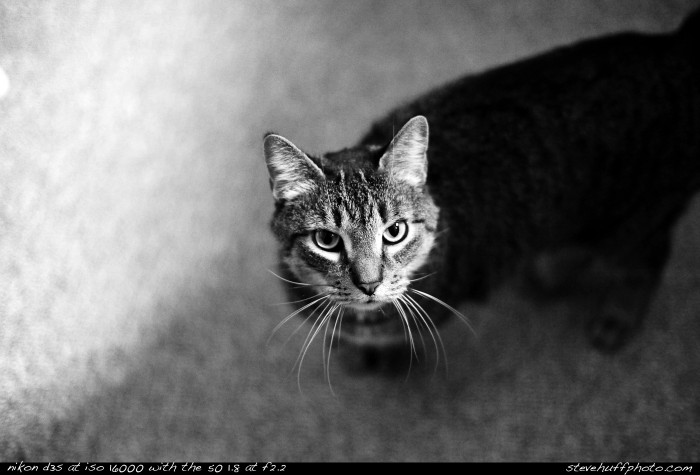
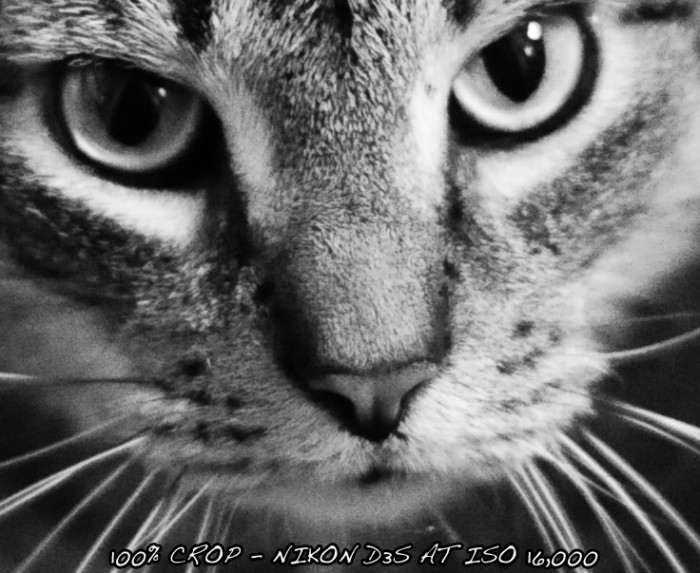
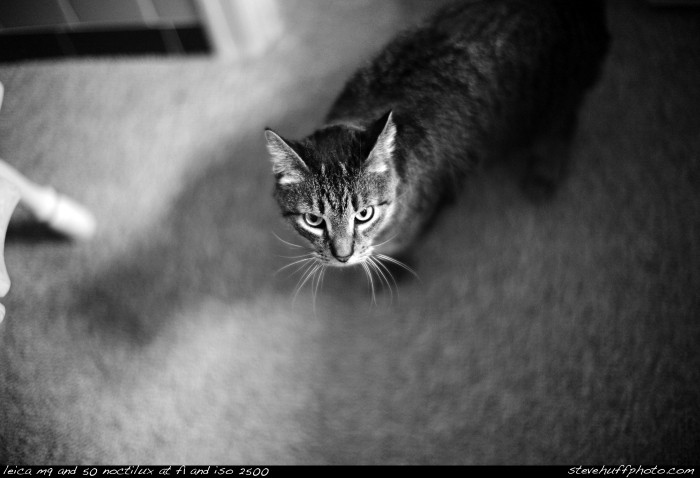
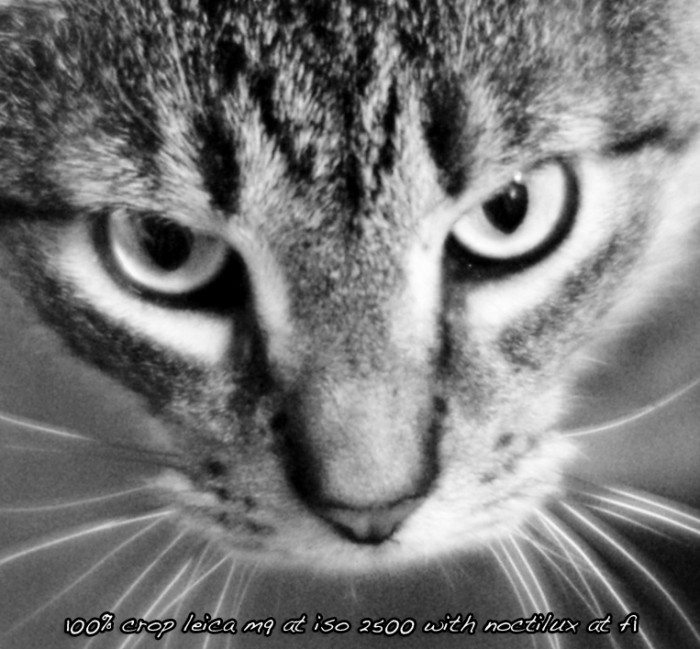
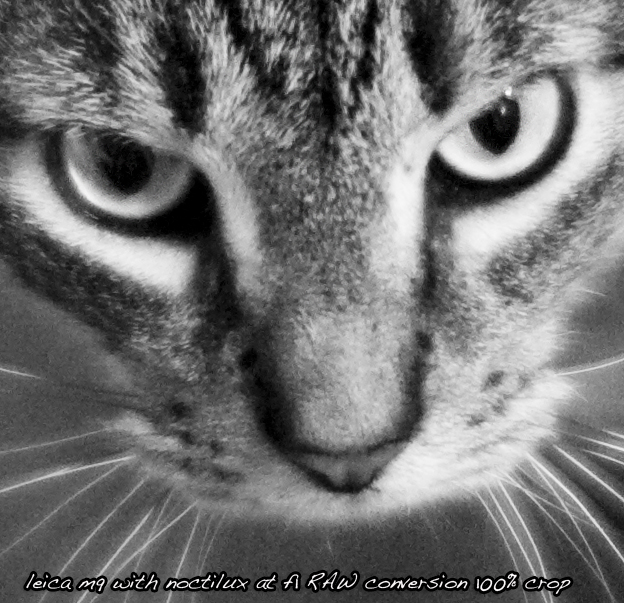


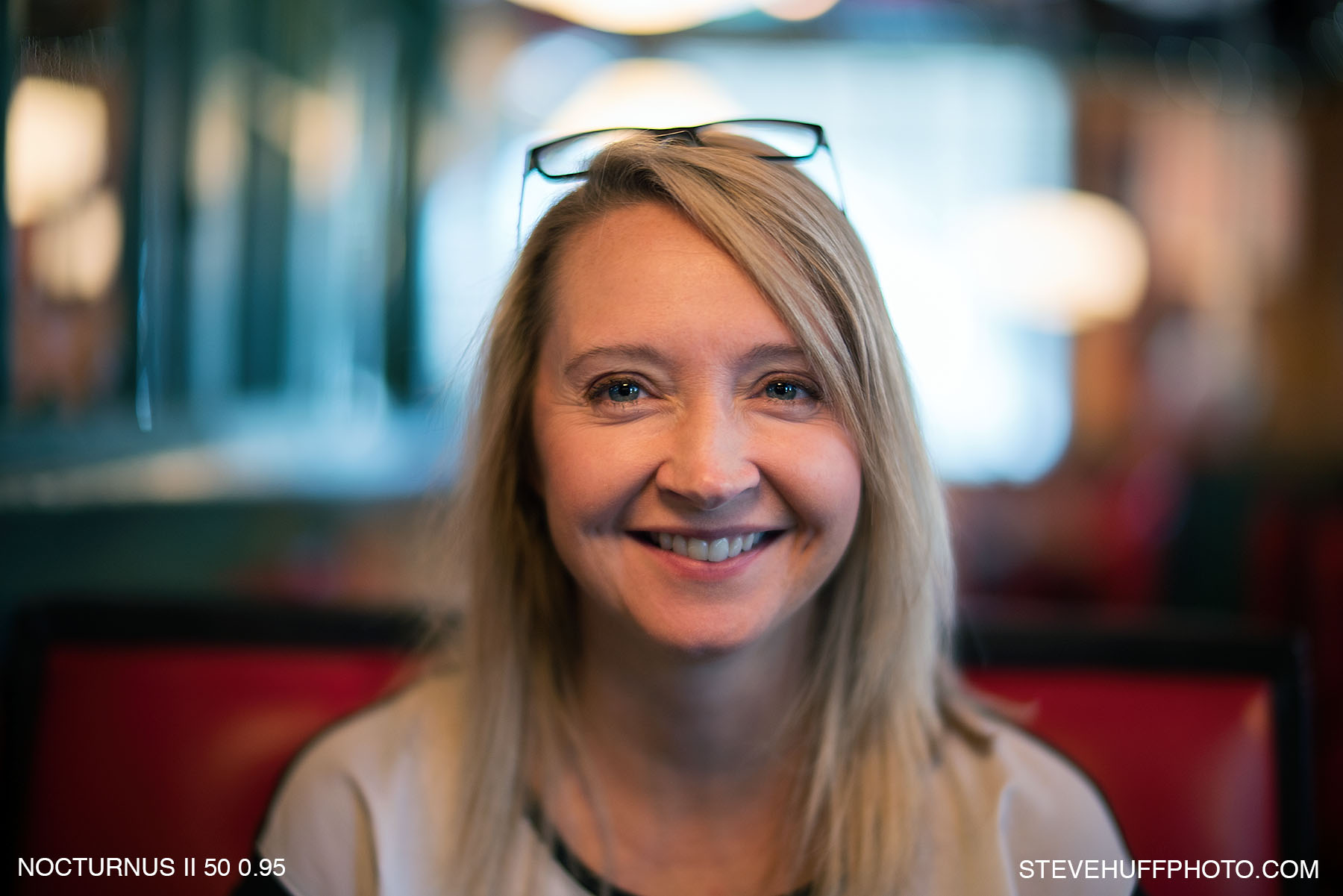
why doing test in BW, this way noise does’t really show up. M9 is terribly noisy already in 800 iso, nikon has no grain in that speed. Next thing is to choose subject, that doesn’t move, this way your “model” is in different spots and it makes hard to campare (if you could in color)..
Nikon D3s :Sensor
• 36 x 23.9 mm CMOS sensor
Leica M9:Sensor
Sensor size Full frame (36 x 24 mm) ?
Sensor type CCD
http://1x.com/forum/equipment/cameras/23317/ccd-vs-cmos-adventages-and-disadventages-
see Puneet Dembla’s comment.
As an available light 35mm shooter, recent developments in high ISO digital have amazed and scared me a little bit. But I will contend that noisy digital and grainy film are just two totally different looks and I prefer grain to noise for most of my work. To me, digital noise is something to be avoided and as digital ISO’s increase, we will want to suppress the noise as much as possible. Whereas with film, particularly small 35mm format, big chunky grain makes images like impressionist paintings. I invite film grain at high speed and do not wish, in many cases, to reduce it. It’s exciting to see low light photography pushed further and further though, even if all I see are pixels!
I have only ventured to ISO 6400 but know from trying it in with various brand and model lenses, that optics make a huge difference at high speed where the sensor/film is “compromised.”
While the Leitz Noctilux is a badass lens for bragging and subjective art but, at 1.1, I’m not aware of many lenses that actually perform as well as 1.4, and particular f2 50mm lenses. The Noctilux displays pronounced bokeh swirl (obvious above) as well as strong vignetting and of course softness and low contrast wide open. I’m confident that a cheaper Leitz 50mm would actually yield “better” results. There is a Nikon to M adaptor you could use to even the results by mounting the same lens to each camera.
Below is an example with my Leica M6 TTL with a cheap Voigtlander 75mm 2.5 mounted (the url won’t seem to work here.) The film is TMAX P3200 rated at 6400 and processed in HC110 (which is a grain/contrast enhancer.) This was scanned to the around the equivalent of an aps-c digital jpg. I share this to bring high speed 35mm into the discussion as being competitive to high speed digital as well as to compare lenses and open some questions about your test.
http://www.flickr.com/photos/johnnymartyr/5122368837/in/set-72157625126959089/
Fun write-up, thank you!
Hi Steve,
I just took my Leica M9 with the new Summilux 1.4 lens to Singapore and tried to take photos at their Night Safari. To me, it felt like I was seriously impaired. Almost all the photos of animals from afar in the dark turned out blurry, even when turned up to 2500 ISO. The only photos that turned out alright were of my wife and kids, and even those were only good after some serious noise reduction in Lightroom. Of course, the Night safari is really very dark, pretty much to the point that you have a hard time focusing since you really could barely see anything. The animals were dimly lighted so that you can see them, but they are far away and the tram was moving. Anyway, I can’t help but feel that if I had taken my Canon 5D Mk2, the results would have been much better. I have taken photos of people in the dark (literally could only see their silhouette with the naked eye) at super high ISO like H1 and have the photos come out with better results. Just don’t know what I am doing wrong with the Leica. Most pictures taken with the Leica of landscapes and people, especially still objects turn out quite nice, but when it comes to movement, and seriously low light, I just find it to be inadequate. Hope you would give some tips on how to deal with my Night Safari scenario.
Thank you.
Hi Wolfgang –
The reason Leica can’t get high ISOs is because they use a CCD sensor. If they stuck a CMOS in there, you’d get much higher ISOs.
So, Dear Leica, for the M10, please stick a CMOS chip in!
Back on topic – thanks for this comparo Steve. Very helpful, as always. It’s amazing how good the quality of the Nikon really is – especially when you do a side by side like this……….
Sometimes I wonder how we all survived the days of film with those puny ISO speeds and grain. Frankly, I am more puzzled at why my M9 can’t give me better resolution and colors than my 50 year old M3 loaded with Kodachrome or Fuji Velvia 50/100 or even TMax 100. After all this is 2010. Could it be maybe because if they ever do reach that pinnacle it will be the last model of camera they will ever sell?
Thanks Steve for doing this sort of crazy things! I still wonder why Leica can’t get really high ISOs right. And though IMHO the file quality can’t make up for the ISO shortcomings I realize once more: You can’t have everything… 😉
Steve , I found the speed used in your pictures EXIF.
Nikon : ISO 16000 1/320 f/2 (you wrote you used 2.2, the EXIF doesn’t agree : ?)
Leica : ISO 2500 1/125 f/1
Steve, I hope you will do a comparative test with Canon 1d MKIV as well.
Just imagine it the other way around – a Leica M with the D3s sensor capabilities…. M10 maybe? 🙂
Hi Steve, great experiment – although a D3s + 50f1.8 is much cheaper than an M9 + Noctilux… ;o)
Could you give us the speed used in both shots – for information ? What I wonder is : could you have made the shot with, say, the 50 Summilux ?
PS/ I was at the Leica Shop in Paris yesterday, next time I go there is to make my order :o)
Test shots here : http://www.flickr.com/photos/thual/sets/72157623095374490/
Bonus question : I own a 35 Summicron IV bought new in 1996, a second hand 50 Summicron (Canada, I think 5th version from mid 80’s) and a second hand 90 Elmarit (Canada, mid 80’s too) + a Voigtlander 15f4.5 (screw mount). If you have an opinion on those lenses, which one I should get rid of and replace soon, I’m interested !
Oh and congratulations for the iPhone version of your website, I can read you anywhere now ! Works great ! :o)
Hello,
Why not to put Zeiss lens on Ds3 ?
Best Regards,
Pascal
nicely done, the m9 is awesome.